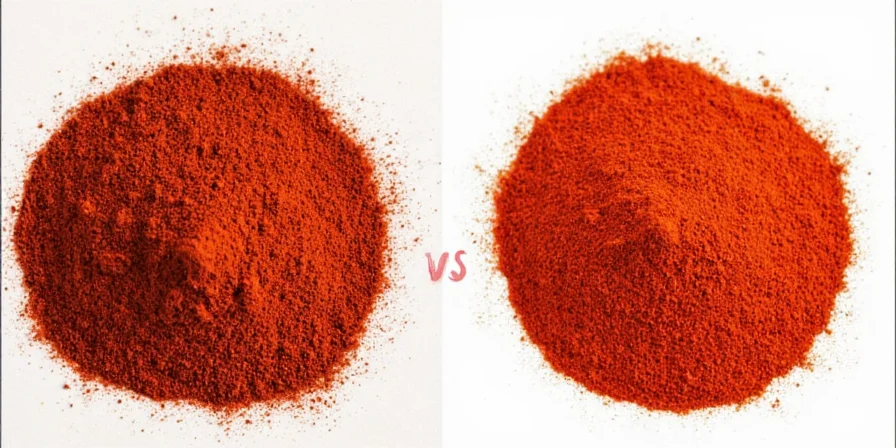If you're wondering what the real difference is between smoked paprika and regular paprika, here's the direct answer: smoked paprika is made by smoke-drying peppers over wood fires, giving it a distinct smoky flavor, while regular paprika is air-dried, preserving the pepper's natural sweet and slightly floral notes. The key difference isn't just flavor—it affects which dishes each type works best in, and substituting one for the other can dramatically change your results.
This complete guide answers exactly what home cooks need to know about choosing between smoked and regular paprika, with practical substitution advice, common usage mistakes to avoid, and simple flavor pairing guidelines you can apply immediately in your kitchen. Forget confusing technical jargon—this is the straightforward comparison you've been looking for.
Smoked Paprika vs Regular Paprika: The Essential Differences
When standing in front of your spice rack trying to decide which paprika to use, you need clear, actionable information—not chemistry lectures. Here's what actually matters for your cooking:
| Key Difference | Regular Paprika | Smoked Paprika |
|---|---|---|
| How It's Made | Air-dried (usually sun-dried) | Smoke-dried over wood fires for days |
| Flavor Profile | Sweet, slightly floral, mild pepper flavor | Smoky, earthy, with deeper complexity |
| Best Used In | Recipes needing color and mild pepper flavor (goulash, deviled eggs) | Dishes where smoky flavor enhances (chili, roasted vegetables, barbecue) |
| Common Substitution Mistake | Using in place of smoked paprika when you want smoky flavor | Using in delicate dishes where smoke overwhelms |
When to Use Each Type: Practical Guidance for Home Cooks
Most home cooks make these paprika mistakes. Here's how to choose correctly every time:
Choose Regular Paprika When:
- You're making classic Hungarian dishes like goulash or chicken paprikash
- Creating light-colored sauces where you want red color without smokiness
- Preparing deviled eggs or potato salad (smoked would overpower)
- Using in baking applications like savory muffins
Choose Smoked Paprika When:
- You want to add 'grill-like' flavor to indoor-cooked dishes
- Making chili, stews, or braised meats
- Enhancing roasted vegetables (especially potatoes and peppers)
- Creating authentic Spanish dishes like patatas bravas

Can You Substitute One for the Other? The Real Answer
This is what most people actually want to know: yes, you can substitute, but with important caveats.
- Substituting smoked for regular: Use ⅓ less smoked paprika than regular to avoid overpowering dishes. Best for hearty recipes like chili, but avoid in delicate applications.
- Substituting regular for smoked: You'll lose the smoky element. Add ¼ teaspoon liquid smoke per teaspoon of smoked paprika needed, but this isn't ideal for all dishes.
- Best substitution rule: If a recipe specifically calls for one type, use that type. Substitutions work best in emergency situations.

Common Mistakes That Ruin Your Dishes
- Using smoked paprika in deviled eggs - the smoke flavor overwhelms the delicate egg
- Assuming all smoked paprika is hot - Spanish varieties come in sweet (dulce), medium (agridulce), and hot (picante)
- Storing paprika in clear containers - light degrades flavor; keep in opaque containers away from heat
- Using expired paprika - both types lose potency after 6-12 months; replace when color fades
- Cooking at too high temperature - causes bitterness; add toward the end of cooking

Quick Reference: Paprika Cheat Sheet
| If You Want... | Use This Type | Try This Recipe |
|---|---|---|
| Classic pepper flavor | Regular (Hungarian) | Traditional goulash |
| Smoky barbecue flavor | Smoked (Spanish) | Veggie chili |
| Mild background flavor | Regular (sweet) | Deviled eggs |
| Rich, complex depth | Smoked (medium-hot) | Roasted potatoes |
Buying and Storing Tips That Actually Work
- Check the label - authentic smoked paprika will say "smoked" or "pimentón"; regular may specify "Hungarian" or "sweet"
- Buy small quantities - spices lose potency; 2-3 ounce containers are ideal for home use
- Store properly - in a cool, dark place (not above the stove!), in airtight containers
- Test freshness - rub a pinch between fingers; fresh paprika has strong aroma and vibrant color
- Freeze for longevity - extends shelf life to 18-24 months (thaw before use)

Frequently Asked Questions
Q: What's the main difference between smoked and regular paprika?
A: Smoked paprika is dried over wood fires giving it a distinct smoky flavor, while regular paprika is air-dried, preserving the pepper's natural sweet and mild flavor. This fundamental difference affects which dishes each works best in.
Q: Can I substitute regular paprika for smoked paprika?
A: Yes, but with limitations. Regular paprika won't provide the smoky flavor. For best results, use 1 teaspoon regular paprika plus ⅛ teaspoon liquid smoke per teaspoon of smoked paprika needed, but this works better in some recipes than others.
Q: Why does my paprika taste bitter?
A: Paprika becomes bitter when exposed to high heat. Always add it toward the end of cooking or bloom it gently in oil at low temperatures. Old or improperly stored paprika can also develop off-flavors.
Q: What's the difference between Spanish and Hungarian paprika?
A: Spanish paprika is typically smoked (pimentón) and comes in sweet, semi-sweet, and hot varieties. Hungarian paprika is usually not smoked and ranges from mild to hot, with deeper earthy notes ideal for traditional dishes like goulash.
Q: How long does paprika last?
A: Properly stored, regular paprika lasts 6-8 months while smoked paprika lasts 8-12 months due to the preservative effect of the smoke compounds. Store in a cool, dark place in an airtight container.











 浙公网安备
33010002000092号
浙公网安备
33010002000092号 浙B2-20120091-4
浙B2-20120091-4